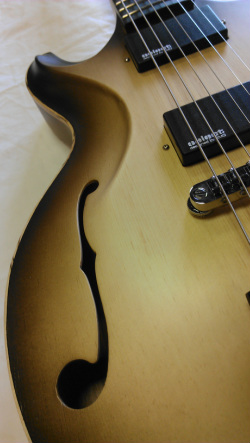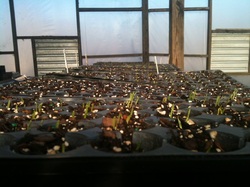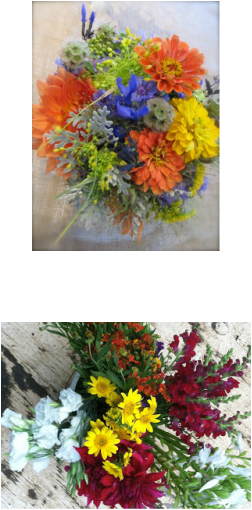Spring 2014 Selected Proposals
On May 4, 2014, SEAM will host its second participatory-grant dinner. This dinner will be a locally-sourced, vegetarian family-style dinner at Basil's Fresh Pasta and Deli in Boone, NC. At the dinner, three outstanding projects will be featured, and ticket sales will provide funding for each project, with varying levels of investment. Following the presentations, dinner attendees will then choose to fund each project at three levels (60%, 30%, and 10%) of the crowd-sourced funds raised through the dinner tickets. All are invited to attend. Tickets may be purchased here.
Duplicating Machine

My name is Chris Capozzoli, I have been a wood worker up here in the High Country since 2000. My passion for woodworking and music has led me to building guitars and custom stringed instruments. I have been an entrepreneur since 2010, after working for a top notch wood shop for ten years. I build custom furnishings, entry ways, and anything out of wood for people up here in the Boone area. I want to transition into building guitars full time. Building guitars is therapy for me. When I’m in my shop creating there is nothing that can distract or disrupt my mood. I have a great appreciation for making stringed instruments because “music makes the world go ‘round”. It also uses way less material than any piece of furniture or front door would. I am part of the forest stewardship council (FSC) and practice sustainable building. I use mostly reclaimed wood and new wood I buy only comes from suppliers that are FSC certified that practice sustainable harvesting. It hurts me to see the destruction of one of our planets biggest resources (trees). I love how making instruments takes such a small amount of wood. I could build 20 guitars with the wood I use to build one entry door. That is too big of a carbon foot print coming off my soul. My goal is to keep my foot print to a responsible small amount and guitar making will do that for me.
In order to build full time I need to set up my shop with equipment and machines to make my work time more efficient. I have designed a machine (the duplicator) to help me out with this. These machines are available on the market but they cost around $3000 or more. The machine I’ve designed will cost approximately $1200 to build. This tool will help me duplicate carved tops and backs for my guitars, basses, and mandolins from an original template that I’ll carve out by hand. I can consolidate my rough carving time from about eight hours down to one hour per top or back. And also be one hundred percent more consistent from instrument to instrument.
Most all guitar manufacturing shops have some type of duplicating or reproducing machine to speed up work time and to help keep consistency through out their product. Bigger shops use computer controlled (CNC) machines to reproduce their body stock. I am more of a traditionalist to this art so I want to keep the computers out of the equation for now. The second best thing is a manual duplicator.
The duplicating machine will consist of a 3/4 horse power router mounted to a carriage that manually moves along an X Y & Z access using linear bearings and hard settle tracks. I’ll have a local machine shop manufacture the carriage assembly out of steel for me. The router will come from Lowes hardware. The rest of the parts will come from an online company that supplies linear bearings and tracks for CNC machines (VXB.com). The whole assembly will sit on top of a four foot by seven foot work bench.
This machine is the next step in the process for me to build custom stringed instruments full time and represent Boone and the high country as a local artisan and luthier. I love this place and I love woodworking. I’m proud to call Boone home and I’m passionate about building guitars here in these hills.
This project will cost approximately $1200 to build.
My budget:
In order to build full time I need to set up my shop with equipment and machines to make my work time more efficient. I have designed a machine (the duplicator) to help me out with this. These machines are available on the market but they cost around $3000 or more. The machine I’ve designed will cost approximately $1200 to build. This tool will help me duplicate carved tops and backs for my guitars, basses, and mandolins from an original template that I’ll carve out by hand. I can consolidate my rough carving time from about eight hours down to one hour per top or back. And also be one hundred percent more consistent from instrument to instrument.
Most all guitar manufacturing shops have some type of duplicating or reproducing machine to speed up work time and to help keep consistency through out their product. Bigger shops use computer controlled (CNC) machines to reproduce their body stock. I am more of a traditionalist to this art so I want to keep the computers out of the equation for now. The second best thing is a manual duplicator.
The duplicating machine will consist of a 3/4 horse power router mounted to a carriage that manually moves along an X Y & Z access using linear bearings and hard settle tracks. I’ll have a local machine shop manufacture the carriage assembly out of steel for me. The router will come from Lowes hardware. The rest of the parts will come from an online company that supplies linear bearings and tracks for CNC machines (VXB.com). The whole assembly will sit on top of a four foot by seven foot work bench.
This machine is the next step in the process for me to build custom stringed instruments full time and represent Boone and the high country as a local artisan and luthier. I love this place and I love woodworking. I’m proud to call Boone home and I’m passionate about building guitars here in these hills.
This project will cost approximately $1200 to build.
My budget:
- 3/4 horse power router $180
- steel carriage assembly $175
- 20mm bearing twin block slide unit open linear x2 $47.37
- 20mm 60” rail guideway system linear motion x2 $157.49
- 1 1/2” shaft suport x2 $39.95
- 1 1/2” adjustable ball bushing (carriage slide) x2 $95.95
- 1 1/2” x 48” steel shaft (carriage shaft) $81.77
- 4- 1/2” x 2” x 4” aluminum stock $?
- 3/4” x 4’ x 8’ plywood x2 $40
- total approximate material cost $1198.29 + aluminum stock
Seed Germination Chamber

My name is Caroline Hampton, I am a sustainable vegetable, herb, and flower producer in my first season, farming at the Farmer Incubator and Grower (F.I.G.) Farm in Valle Crucis under the name Octopus Garden. I would like to build a germination chamber for starting seeds at the FIG Farm. A germination chamber is any type of insulated box with a heating element in it. Seeded trays are put in the germination chamber and the temperature is regulated by switching the heating element on and off depending on the reading from a thermometer inserted in the soil of one of the trays, so that the chamber does not overheat. There are many different designs out there, including that of my former employers and mentors at Loon Organics in Hutchinson, MN, and one on the Farmhack website as seen here. The germination chamber is fairly easy to build and inexpensive. My materials should only cost me about $350.
The FIG Farm is a collaborative project between several small producers, and sharing resources means limited space. We are already struggling with spacial constraints in our greenhouse when the season has barely started! With a germination chamber, we will be able to better utilize our space, placing newly seeded trays in the germination chamber, and only putting them out in the greenhouse once they have sprouted.
A germination chamber would be helpful to us at FIG most importantly because it will create ideal conditions for seeds to sprout- a constantly moist and warm environment. Most vegetable seeds germinate best at a temperature of between 75 and 90 degrees, and outside of this optimal temperature range, you are likely to experience slower germination, sometimes making a different of as much as a week or more in the time it takes for seedlings to sprout. A week’s difference in timing or even a few days can make a big difference when you are trying to produce food with certain goals for selling at markets, etc. I will be selling at the Watauga Farmer’s Market, and having produce to sell when the Farmer’s Market opens is important for my business.
It is cold outside right now, especially at night, which explains why seeds are slow to germinate. But even once it gets warmer, seeds will sprout quickest and most reliably in the ideal environment created by the germination chamber. A germination chamber will help the growers at the FIG Farm keep our production on track and free up more space in our greenhouse. This germination chamber is extremely important for me and if I do not receive funds from SEAM I will seek other ways to fund the construction of the chamber because it is so necessary to my success and something that I will continue to use long into the future. I hope that you will consider this project for a SEAM grant. Thank you!
The FIG Farm is a collaborative project between several small producers, and sharing resources means limited space. We are already struggling with spacial constraints in our greenhouse when the season has barely started! With a germination chamber, we will be able to better utilize our space, placing newly seeded trays in the germination chamber, and only putting them out in the greenhouse once they have sprouted.
A germination chamber would be helpful to us at FIG most importantly because it will create ideal conditions for seeds to sprout- a constantly moist and warm environment. Most vegetable seeds germinate best at a temperature of between 75 and 90 degrees, and outside of this optimal temperature range, you are likely to experience slower germination, sometimes making a different of as much as a week or more in the time it takes for seedlings to sprout. A week’s difference in timing or even a few days can make a big difference when you are trying to produce food with certain goals for selling at markets, etc. I will be selling at the Watauga Farmer’s Market, and having produce to sell when the Farmer’s Market opens is important for my business.
It is cold outside right now, especially at night, which explains why seeds are slow to germinate. But even once it gets warmer, seeds will sprout quickest and most reliably in the ideal environment created by the germination chamber. A germination chamber will help the growers at the FIG Farm keep our production on track and free up more space in our greenhouse. This germination chamber is extremely important for me and if I do not receive funds from SEAM I will seek other ways to fund the construction of the chamber because it is so necessary to my success and something that I will continue to use long into the future. I hope that you will consider this project for a SEAM grant. Thank you!
SLR Camera

Shady Grove Gardens & Nursery is a non-certified organic cut flower grower. Our primary market is wedding flowers. We sell directly to brides in addition, we offer value-added floral design for all types for weddings. In this market, we need a very visual social media presence. Most brides are under 30 and use the internet to make buying decisions for their wedding flowers.
I am requesting up to $600 for the purchase of a digital SLR camera to help sell our product of locally grown wedding flowers. Our young brides use social media of all types, each requires quality high resolution photos to catch their imagination.
My film camera will no longer fill the void. Neither will my pocket point and shoot it lacks the ability to change focal planes for a soft romantic focus. I am in need of a camera that can handle a macro lens and allow aperture adjustment to shorten the focal plane.
I am familiar with SLR cameras. I won't need a class. I've had photos published in the past. I'm just looking to get a camera to keep my portfolio up to date and interact with my brides on social media.
I have missed out on inclusion in wedding blog posts and being in a new book because I did not have quality high resolution photos to send in. I would like to remedy that situation.
The camera will be used to take farm and flower photos for our website. It will be used to take and share photos on our blog and Facebook. I would like to start an instagram account to share there as well.
The most important photos will be photos of our locally grown flowers made into beautiful floral wedding designs and shared as our portfolio. I can also have these better quality photos made into a book that will act as my portfolio at the farmers market and bridal shows.
I am requesting up to $600 for the purchase of a digital SLR camera to help sell our product of locally grown wedding flowers. Our young brides use social media of all types, each requires quality high resolution photos to catch their imagination.
My film camera will no longer fill the void. Neither will my pocket point and shoot it lacks the ability to change focal planes for a soft romantic focus. I am in need of a camera that can handle a macro lens and allow aperture adjustment to shorten the focal plane.
I am familiar with SLR cameras. I won't need a class. I've had photos published in the past. I'm just looking to get a camera to keep my portfolio up to date and interact with my brides on social media.
I have missed out on inclusion in wedding blog posts and being in a new book because I did not have quality high resolution photos to send in. I would like to remedy that situation.
The camera will be used to take farm and flower photos for our website. It will be used to take and share photos on our blog and Facebook. I would like to start an instagram account to share there as well.
The most important photos will be photos of our locally grown flowers made into beautiful floral wedding designs and shared as our portfolio. I can also have these better quality photos made into a book that will act as my portfolio at the farmers market and bridal shows.

